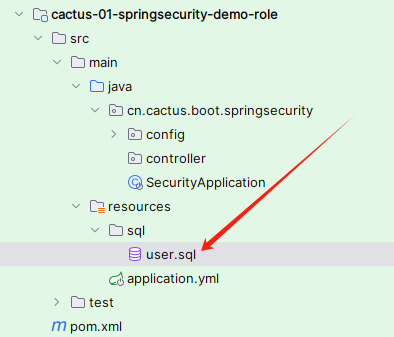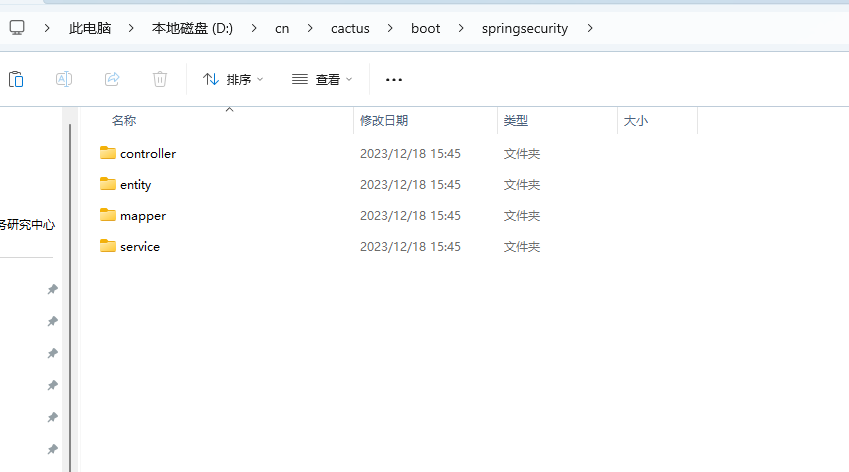认证篇之使用数据库存储用户
1. 简介
在用户认证过程中,常见的方式是通过用户名和密码进行验证。认证服务首先根据提供的用户名从存储中检索用户信息,随后验证输入的密码是否与存储中的密码匹配。Spring Security 提供多种灵活的用户名和密码存储机制供选择,如下:
内存:将用户信息直接配置在内存中,适用于小型应用或者测试环境。这种方式的配置相对简单,但不适合生产环境。
@Override protected void configure(AuthenticationManagerBuilder auth) throws Exception { auth .inMemoryAuthentication() .withUser("user").password("password").roles("USER") .and() .withUser("admin").password("admin").roles("USER", "ADMIN"); }
关系型数据库:使用关系型数据库存储用户信息,Spring Security提供了默认的数据库表结构,也可以进行自定义表结构。
@Autowired private DataSource dataSource; @Override protected void configure(AuthenticationManagerBuilder auth) throws Exception { auth .jdbcAuthentication() .dataSource(dataSource) .usersByUsernameQuery("SELECT username, password, enabled FROM users WHERE username=?") .authoritiesByUsernameQuery("SELECT username, authority FROM authorities WHERE username=?"); }在上述配置中,通过
usersByUsernameQuery和authoritiesByUsernameQuery指定了查询用户信息和权限信息的SQL语句。
使用
UserDetailsService的自定义数据存储:实现自定义的UserDetailsService接口,从任何数据源加载用户信息。这种方式适用于各种非关系型数据库或其他数据源。@Service public class CustomUserDetailsService implements UserDetailsService { @Autowired private UserRepository userRepository; @Override public UserDetails loadUserByUsername(String username) throws UsernameNotFoundException { User user = userRepository.findByUsername(username); if (user == null) { throw new UsernameNotFoundException("User not found with username: " + username); } return new CustomUserDetails(user); } }然后在配置中使用自定义的
UserDetailsService:@Autowired private UserDetailsService userDetailsService; @Override protected void configure(AuthenticationManagerBuilder auth) throws Exception { auth.userDetailsService(userDetailsService); }
使用
LDAP认证的LDAP存储:如果你的用户信息存储在LDAP目录中,可以使用Spring Security对LDAP的支持。@Override protected void configure(AuthenticationManagerBuilder auth) throws Exception { auth .ldapAuthentication() .userDnPatterns("uid={0},ou=people") .groupSearchBase("ou=groups") .contextSource() .url("ldap://localhost:389/dc=springframework,dc=org") .managerDn("cn=admin,dc=springframework,dc=org") .managerPassword("password"); }上述配置中,通过LDAP连接进行用户认证和授权。
本篇文档主要学习使用数据库存储用户信息。
2. 环境搭建
2.1 创建用户表
创建数据库并执行源码地址中的SQL脚本:

2.2 集成 Mybatis Plus
引入Mybatis Plus、Mysql等程依赖开发工具包:
<dependencies>
<!-- 进行 Spring MVC 的自动化配置 -->
<dependency>
<groupId>org.springframework.boot</groupId>
<artifactId>spring-boot-starter-web</artifactId>
</dependency>
<!-- 进行 Spring Security 的自动化配置 -->
<dependency>
<groupId>org.springframework.boot</groupId>
<artifactId>spring-boot-starter-security</artifactId>
</dependency>
<!-- 进行 Mybatis-Plus 的自动化配置 -->
<dependency>
<groupId>com.baomidou</groupId>
<artifactId>mybatis-plus-boot-starter</artifactId>
<version>3.5.4.1</version>
</dependency>
<!-- 进行数据库的连接 -->
<dependency>
<groupId>com.mysql</groupId>
<artifactId>mysql-connector-j</artifactId>
<scope>runtime</scope>
</dependency>
<!-- 进行实体类动态生成set、get等信息的生成 -->
<dependency>
<groupId>org.projectlombok</groupId>
<artifactId>lombok</artifactId>
</dependency>
<!-- 集成各种常用的工具包 -->
<dependency>
<groupId>cn.hutool</groupId>
<artifactId>hutool-all</artifactId>
<version>5.7.21</version>
</dependency>
</dependencies>在 application.yml 中配置数据源信息:
server:
# 服务端口
port: 8888
spring:
# DataSource Config
datasource:
type: com.zaxxer.hikari.HikariDataSource
driver-class-name: com.mysql.cj.jdbc.Driver
url: jdbc:mysql://192.168.1.19:3306/security-user?zeroDateTimeBehavior=convertToNull&useUnicode=true&characterEncoding=UTF-8&serverTimezone=Asia/Shanghai&autoReconnect=true
username: root
password: Nstr.234808在启动类上添加 @MapperScan 扫描:
@SpringBootApplication
@MapperScan("cn.cactus.boot.springsecurity.mapper")
public class SecurityApplication {
public static void main(String[] args) {
SpringApplication.run(SecurityApplication.class, args);
}
}2.3 集成生成代码工具
使用Mybatis Plus代码生成器生成各层代码。首先引入代码生成器和模板引擎:
<!--代码生成器-->
<dependency>
<groupId>com.baomidou</groupId>
<artifactId>mybatis-plus-generator</artifactId>
<version>3.5.2</version>
</dependency>
<dependency>
<groupId>org.freemarker</groupId>
<artifactId>freemarker</artifactId>
<version>2.3.31</version>
</dependency>添加生成工具类,修改一些数据库地址、包名等参数:
public class AutoGeneratorUtils {
public static void main(String[] args) throws IOException, URISyntaxException {
String encode = new BCryptPasswordEncoder().encode("123456");
System.out.println(encode);
FastAutoGenerator.create("jdbc:mysql://192.168.1.19:3306/security-user", "root", "Nstr.234808")
.globalConfig(builder -> {
builder.author("cactusli") // 设置作者
.enableSwagger() // 开启 swagger 模式
.fileOverride() // 覆盖已生成文件
.outputDir("D://"); // 指定输出目录
})
.dataSourceConfig(builder -> builder.typeConvertHandler((globalConfig, typeRegistry, metaInfo) -> {
int typeCode = metaInfo.getJdbcType().TYPE_CODE;
if (typeCode == Types.SMALLINT) {
// 自定义类型转换
return DbColumnType.INTEGER;
}
return typeRegistry.getColumnType(metaInfo);
}))
.packageConfig(builder -> {
builder.parent("cn.cactus.boot.springsecurity") // 设置父包名
//.moduleName("system") // 设置父包模块名
.pathInfo(Collections.singletonMap(OutputFile.xml, "D://")); // 设置mapperXml生成路径
})
.strategyConfig(builder -> {
builder.addInclude("t_user") // 设置需要生成的表名
.addTablePrefix("t_", "c_"); // 设置过滤表前缀
})
.templateEngine(new FreemarkerTemplateEngine()) // 使用Freemarker引擎模板,默认的是Velocity引擎模板
.execute();
}
}把生成的代码复制到项目中:

2.4 测试验证代码
在 pom.xml 文件中 引入 Spring Boot Test 测试启动场景依赖。
<dependency>
<groupId>org.springframework.boot</groupId>
<artifactId>spring-boot-starter-test</artifactId>
<scope>test</scope>
</dependency>在 test 目录下新建 CactusSpringSecurityDemoTest 测试类代码如下:
@SpringBootTest
class CactusSpringSecurityDemoTest {
@Resource
private IUserService userService;
@Test
void testSelectUser() {
User test = userService.getOne(new LambdaQueryWrapper<User>().eq(User::getUserName, "test"));
System.out.println(test);
}
}代码成功运行后会输出以下日志:

3. 用户登录
3.1 首先看UserDetailsService接口
这里我们需要从数据库中获取用户信息,Spring Security提供了UserDetailsService接口查询用户数据。
该接口中,只声明了一个根据用户名加载用户信息的方法:
// 加载用户特定数据的核心接口。
// 它在整个框架中用作用户 DAO,并且是 DaoAuthenticationProvider.
// 该接口只需要一种只读方法,这简化了对新数据访问策略的支持。
public interface UserDetailsService {
/**
根据用户名定位用户。在实际实现中,搜索可能区分大小写,也可能不区分大小写,具体取决于实现实例的配置方式。在这种情况下, UserDetails 返回的对象可能具有与实际请求的用户名不同的用户名。
参数:username – 标识需要其数据的用户的用户名。
返回:完全填充的用户记录(从不 null)
抛出:UsernameNotFoundException – 如果找不到用户或用户没有 GrantedAuthorit
*/
UserDetails loadUserByUsername(String username) throws UsernameNotFoundException;
}Spring Security默认提供了几个实现类:

从类名称已经比较好理解,支持内存、数据库查询用户。首先我们看下JdbcDaoImpl是如何查询用户的,是不是满足我们的业务要求。
查看其loadUserByUsername方法执行逻辑:
@Override
public UserDetails loadUserByUsername(String username) throws UsernameNotFoundException {
// select username,password,enabled from users where username = ?
// 1. JdbcTemplate 执行SQL
List<UserDetails> users = loadUsersByUsername(username);
if (users.size() == 0) {
// 2. 没有查询到,抛出 UsernameNotFoundException
this.logger.debug("Query returned no results for user '" + username + "'");
throw new UsernameNotFoundException(this.messages.getMessage("JdbcDaoImpl.notFound",
new Object[] { username }, "Username {0} not found"));
}
// 3. 如果查询多条用户信息,则取第一条数据
UserDetails user = users.get(0); // contains no GrantedAuthority[]
Set<GrantedAuthority> dbAuthsSet = new HashSet<>(); // 存放用户授予的权限
// 4. 开启了查询权限,执行SQL:select username,authority from authorities where username = ?
// 将查询到的结果放入集合中
if (this.enableAuthorities) {
dbAuthsSet.addAll(loadUserAuthorities(user.getUsername()));
}
// 5. 开启了权限分组,=》select g.id, g.group_name, ga.authority from groups g, group_members gm, group_authorities ga where gm.username = ? and g.id = ga.group_id and g.id = gm.group_id
if (this.enableGroups) {
dbAuthsSet.addAll(loadGroupAuthorities(user.getUsername()));
}
// set 不重复集合 =》 list
List<GrantedAuthority> dbAuths = new ArrayList<>(dbAuthsSet);
addCustomAuthorities(user.getUsername(), dbAuths);
// 6. 当前用户没有任何权限,也会抛出 UsernameNotFoundException
if (dbAuths.size() == 0) {
this.logger.debug("User '" + username + "' has no authorities and will be treated as 'not found'");
throw new UsernameNotFoundException(this.messages.getMessage("JdbcDaoImpl.noAuthority",
new Object[] { username }, "User {0} has no GrantedAuthority"));
}
// 7. 创建 UserDetails 类型的用户对象并返回
return createUserDetails(username, user, dbAuths);
}通过以上的源码分析,JdbcDaoImpl中的SQL都是固定的,而且为了更好的扩展,我们可以仿照其逻辑自定义实现UserDetailsService接口。
3.2 UserDetails 接口
UserDetailsService 接口要求返回一个 UserDetails 类型的对象,这个命名本身已经非常直观,它表示一个封装了用户信息的类。我们的任务是将从数据库或其他数据源查询得到的用户对象转换为 Spring Security 框架支持的用户对象,以便进行认证、授权等操作。
UserDetails 接口源码如下:
public interface UserDetails extends Serializable {
// 返回授予用户的权限集合。
Collection<? extends GrantedAuthority> getAuthorities();
// 返回用于对用户进行身份验证的密码。
String getPassword();
// 返回用于对用户进行身份验证的用户名。
String getUsername();
// 用户的帐户是否已过期。无法对过期的帐户进行身份验证
// 返回 true 用户的帐户有效(即未过期), false 不再有效(即已过期)
boolean isAccountNonExpired();
// 用户是已锁定还是已解锁。无法对锁定的用户进行身份验证。
// 返回:true 用户未锁定, false 否则
boolean isAccountNonLocked();
// 用户的凭据(密码)是否已过期。过期的凭据会阻止身份验证。
// 返回:true 用户的凭据有效(即未过期), false 不再有效(即已过期)
boolean isCredentialsNonExpired();
// 用户是启用还是禁用。无法对禁用的用户进行身份验证。
// 返回:true 用户已启用, false 否则
boolean isEnabled();
}Spring Security默认提供了一个实现类User源码如下:

目前来说,框架提供的User类,已经够用,但是本着可能需要扩展的情况,我们也需要自定义实现UserDetails 接口。
3.3 自定义UserDetails 接口
实现 UserDetails接口,代码如下:
@Data
public class CactusUserDetails implements UserDetails {
private String password;
private final String username;
private final String phone; // 扩展字段,手机号放入用户信息中
private final Set<GrantedAuthority> authorities;
private final boolean accountNonExpired;
private final boolean accountNonLocked;
private final boolean credentialsNonExpired;
private final boolean enabled;
public PearlUserDetails( String username,String password, String phone, List<GrantedAuthority> authorities, boolean accountNonExpired, boolean accountNonLocked, boolean credentialsNonExpired, boolean enabled) {
this.password = password;
this.phone = phone;
this.username = username;
this.accountNonExpired = accountNonExpired;
this.accountNonLocked = accountNonLocked;
this.credentialsNonExpired = credentialsNonExpired;
this.enabled = enabled;
this.authorities = Collections.unmodifiableSet(sortAuthorities(authorities)); // 非空判断+排序
}
private static SortedSet<GrantedAuthority> sortAuthorities(Collection<? extends GrantedAuthority> authorities) {
Assert.notNull(authorities, "Cannot pass a null GrantedAuthority collection");
SortedSet<GrantedAuthority> sortedAuthorities = new TreeSet(new PearlUserDetails.AuthorityComparator());
for (GrantedAuthority grantedAuthority : authorities) {
Assert.notNull(grantedAuthority, "GrantedAuthority list cannot contain any null elements");
sortedAuthorities.add(grantedAuthority);
}
return sortedAuthorities;
}
private static class AuthorityComparator implements Comparator<GrantedAuthority>, Serializable {
private static final long serialVersionUID = 600L;
public int compare(GrantedAuthority g1, GrantedAuthority g2) {
// 两者都不应为 null,因为在将每个条目添加到集合之前都会对其进行检查。如果权限为 null,则它是自定义权限,应先于其他权限。
if (g2.getAuthority() == null) {
return -1;
}
if (g1.getAuthority() == null) {
return 1;
}
return g1.getAuthority().compareTo(g2.getAuthority());
}
}
}然后实现UserDetailsService接口,代码如下:
@Slf4j
public class CactusUserDetailsService implements UserDetailsService {
@Resource
IUserService userService;
@Override
public UserDetails loadUserByUsername(String username) throws UsernameNotFoundException {
// 1. 数据库查询用户
User user = userService.getOne(new LambdaQueryWrapper<User>().eq(User::getUserName, username));
if (ObjectUtil.isNull(user)) {
log.error("Query returned no results for user '" + username + "'");
throw new UsernameNotFoundException(StrUtil.format("Username {} not found", username));
} else {
// 2. 设置权限集合,后续需要数据库查询(授权篇讲解)
List<GrantedAuthority> authorityList = AuthorityUtils.commaSeparatedStringToAuthorityList("role");
// 3. 返回UserDetails类型用户
return new CactusUserDetails(username, user.getPassword(), user.getPhone(), authorityList,
true, true, true, true); // 账号状态这里都直接设置为启用,实际业务可以存在数据库中
}
}
}3.4 添加配置类项
Spring Security 6.0和之前的配置有些区别,后续会详细解读。
添加配置类,注入一个密码编码器:
@Configuration
// 开启 Spring Security,debug:是否开启Debug模式
@EnableWebSecurity(debug = false)
public class CactusSecurityConfig {
/**
* 注入自定义 UserDetailsService 实现类
* @return UserDetailsService
*/
@Bean
CactusUserDetailsService cactusUserDetailsService() {
return new CactusUserDetailsService();
}
/**
* 密码器
*/
@Bean
PasswordEncoder passwordEncoder() {
return new BCryptPasswordEncoder();
}
}
}3.5 测试添加用户功能
@Test
@DisplayName("插入一条用户数据")
void insertUserTest() {
User user = new User();
user.setUserName("admin");
user.setPassword(new BCryptPasswordEncoder().encode("ckhop"));
user.setLoginName("管理员");
user.setPhone("17610005681");
userService.save(user);
}查看数据库,显示数据添加成功

3.6 测试登录
启动项目是用新添加的用户进行登录访问测试,在浏览器输入:http://localhost:8888/admin/testString

至此访问首页,使用数据库中的用户、密码登录,集成完毕。